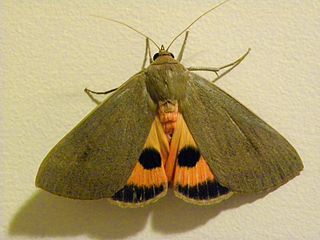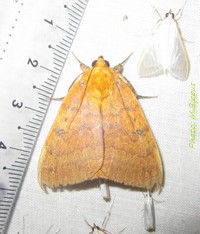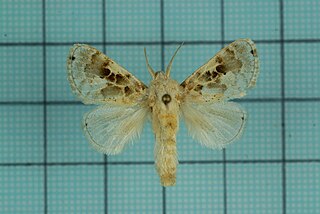
Atteva is a genus of moths in the monotypic family Attevidae. The group has a pantropical distribution; however, the range of at least one species, Atteva aurea, extends into the temperate zone. No consistent hypotheses regarding the relationships, placement, and ranking of Attevidae have been published, but the prevalent view is that they likely form a monophyletic group within the Yponomeutoidea.

The Pyralini are a tribe of snout moths described by Pierre André Latreille in 1809. They belong to the subfamily Pyralinae, which contains the "typical" snout moths of the Old World and some other regions. The genus list presented here is provisional.
Loryma was an ancient town and episcopal see of ancient Caria, in Asia Minor. It is now listed as a titular see. Loryma was a fortified place with a port, close to Cape Cynossema, on the westernmost point of the Rhodian Chersonesus, in Caria. Its harbour was about 20 Roman miles distant from Rhodes and was belonging to the Rhodians. Strabo applies the name Loryma to the whole of the rocky district, without mentioning the town. The Larumna of Pomponius Mela and the Lorimna of the Tabula Peutingeriana perhaps refer to Loryma, although it is also possible that they may be identical with a place called Larymna mentioned by Pliny in the same district.

Achaea is a genus of moths in the family Erebidae described by Jacob Hübner in 1923.

Ectropis is a genus in the geometer moth family (Geometridae). They are mostly paleotropical, but also plentiful in Australia and extend into Asia. Only one species – or cryptic species complex – is found in Europe. There are about 100 known species in this genus.
Delopterus is a monotypic snout moth genus. Its single species, Delopterus basalis, is found in Namibia, South Africa and Zimbabwe. Both the genus and species were first described by Anthonie Johannes Theodorus Janse in 1922.

Loryma is a genus of snout moths described by Francis Walker in 1859.

Herpetogramma basalis is a species of moth in the family Crambidae. It is found on the Canary Islands and in Japan, China, Australia, Sri Lanka, India, Indonesia, La Réunion, South Africa, and Mali.
Loryma athalialis is a species of snout moth in the genus Loryma. It was described by Francis Walker in 1859 and is known from the Democratic Republic of the Congo, South Africa and Madagascar.
Loryma callos is a species of snout moth in the genus Loryma. It was described by Pierre Viette in 1973, and is known from Zimbabwe and has also been found in Madagascar.
Loryma masamalis is a species of snout moth in the genus Loryma. It was described by Patrice J.A. Leraut in 2009 and is known from Madagascar.

Loryma recusata is a species of snout moth in the genus Loryma. It was described by Francis Walker in 1863 and is known from Taiwan, Indonesia, Sri Lanka, India, Thailand, western Malaysia and New Guinea. It has also been recorded from northern Australia and South Africa.
Loryma sentiusalis is a species of snout moth in the genus Loryma. It was described by Francis Walker in 1859 and is known from South Africa.
Orthaga basalis is a species of snout moth in the genus Orthaga. It was described by Frederic Moore in 1888 and is known from India.
Pericyma basalis is a moth of the family Noctuidae. It is found on Madagascar and Réunion.

Altha is a genus of moths of the family Limacodidae first described by Walker in 1862.

Mallada basalis is a species of green lacewing in the family Chrysopidae, first described by Francis Walker in 1853. No subspecies are listed in the Catalog of Life. The species was detected on mainland New Zealand in the 2010s.








